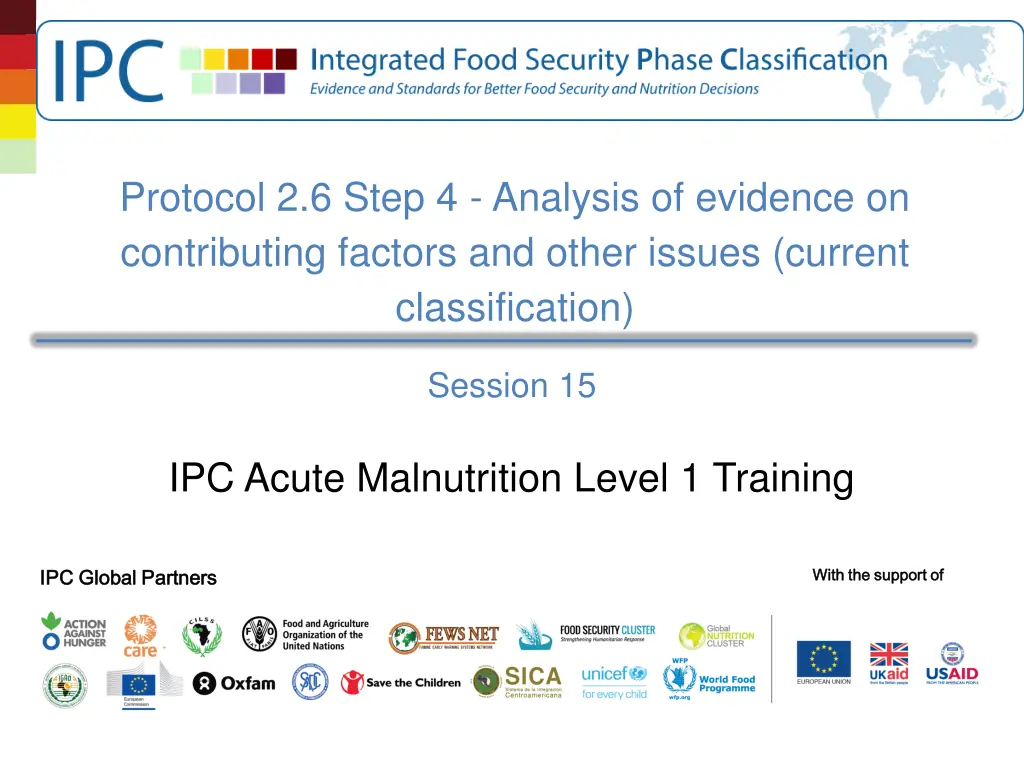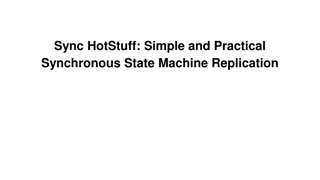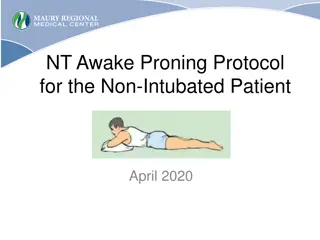
Effective Analysis of Contributing Factors in Acute Malnutrition
Learn the importance of systematically analyzing contributing factors to acute malnutrition, key steps, tools, and procedures involved. Understand the general principles for identifying major factors and specific issues to support program design and response strategies.
Download Presentation

Please find below an Image/Link to download the presentation.
The content on the website is provided AS IS for your information and personal use only. It may not be sold, licensed, or shared on other websites without obtaining consent from the author. If you encounter any issues during the download, it is possible that the publisher has removed the file from their server.
You are allowed to download the files provided on this website for personal or commercial use, subject to the condition that they are used lawfully. All files are the property of their respective owners.
The content on the website is provided AS IS for your information and personal use only. It may not be sold, licensed, or shared on other websites without obtaining consent from the author.
E N D
Presentation Transcript
Protocol 2.6 Step 4 - Analysis of evidence on contributing factors and other issues (current classification) Session 15 IPC Acute Malnutrition Level 1 Training IPC Global Partners IPC Global Partners With the support of With the support of
11 Steps to Classify Severity & Identify Drivers Step 1: Context and analysis parameters Step 2: References for evidence Step 3: Analysis of outcomes (current classification) Step 4: Analysis of evidence on contributing factors and other issues (current classification) Step 5: Phase classification (current) Step 6: Key drivers Step 7 Limitations of analysis Step 8 Priority response objectives Step 9 Analysis of evidence on contributing factors and other issues (projection classification) Step 10 Analysis of outcomes (projection classification) Step 11 Risk factors to monitor
Importance of Step 4 Systematically look at contributing factors to acute malnutrition taking into account contextual information Identify major contributing factors to acute malnutrition to support response analysis and program design 3
The tools and procedures for Step 4 (2/2) Data on contributing factors to acute malnutrition and other specific issues are looked at and analyzed in Step 4 The purpose is to identify major contributing factors to acute malnutrition in each of the analysis area Contributing factors are identified and listed based on the IPC AMN Analytical Framework For each cause of malnutrition in the framework (i.e. immediate, underlying, and basic causes) a list of indicators are included Add additional indicators as necessary Other specific issues to look at are listed separately 5
General principles for analyzing contributing factors Validity period for data on contributing factors is 3 years Most recent data in the past 3 years included in the analysis For indicators affected by seasonality, use information from the same, most recent season, if current data is unavailable Not a statistical analysis Major contributing factors are identified by comparing current prevalence, historical trends, etc. of contributing factors in relation to the current levels of acute malnutrition Thresholds are available for some indicators Expert judgement is used for others 6
Inference of contributing factors Inference Defined: A conclusion reached on the basis of evidence and reasoning. Logical deduction. 2 ways to infer contributing factors: - Interpret: Contributing Factors within their context - Extrapolate: Evidence over space, and time 7
Interpret: Contributing factors within their context What is the current prevalence of a contributing factor? How does it affect the acute malnutrition outcome? E.g. (1): Cholera outbreak affecting 45.9% of children in an analysis area There is a correlation between cholera and acute malnutrition (already established; no need to proof again, e.g. by looking at the correlation between measles and acute malnutrition and the p value) 45.9% of children with cholera can be considered high It is reasonable to conclude that cholera is likely to be a major contributing factor in this area of analysis E.g. (2): Exclusive breastfeeding in an analysis area is 90.3% Breastfeeding has a protective affect on acute malnutrition 90.3% of exclusive breastfeeding is very high It is reasonable to conclude that breastfeeding is likely not a contributing factor in this area of analysis 8
Extrapolate: Evidence over space and time (1/3) Refers to data collected from larger or smaller areas or than that of the areas of analysis; or data collected from different time (i.e. not from the same season of analysis) Analysts need to contextualize evidence, make assumptions and interpret their meaning for outcomes E.g. (1): Information on exclusive breastfeeding (70%) is only available at the regional level (admin level 1) and analysis is carried out at district level (admin level 3) Regional estimate is an average of several districts Some districts may be at >70% others may be at <70% What is the likely situation in the area of analysis? 9
Extrapolate: Evidence over space and time (2/3) E.g. (2): Information on exclusive breastfeeding (40%) is from Sept. 2013 and analysis is carried out in Aug. 2016 There may have been interventions since June 2013 and the situation may have improved Situation might have gotten worse due to urbanization and promotion of BMS? Situation may still be the same? What is the likely situation in the area of analysis? Is it >40%, <40%, or the same? 10
Extrapolate: Evidence over space and time (3/3) E.g. (3): Information on disease prevalence is unavailable but disease trends are available from health facility data Use it as a proxy; although health facility data has inherent weaknesses, it will still provide some indication of the situation Use the data from the same season as the analysis 11
Re-analyze data to get evidence If raw data is available, it can be re-analyzed to generate evidence that otherwise is not available E.g. (1): Only MDD and MMF are reported in a survey report If raw data is available, data can be re-analyzed to calculate MAD E.g. (2): Coverage of all basic vaccinations is not reported in the survey report If raw data is available and there is information on BCG, pentavalent, polio and measles, data can be re-analyzed to calculate coverage of all basic vaccinations 12
Analysis of immediate causes of acute malnutrition 13
Immediate causes: inadequate dietary intake DC, R: Enter the Documentation Code (from the document depository) and Reliability Score Prevalence: Specify the prevalence estimate for the indicator Technical remarks: Describe if there is any concern about the data quality, representativeness of the data, etc. If there are no such issues, there is no need to fill this section; if no concern, leave it blank Other indicators: Add additional indicators as necessary 14
Immediate causes: diseases (Prevalence and Outbreaks) DC, R: Enter the Documentation Code (from the document depository) and Reliability Score Prevalence: Specify the prevalence estimate for the indicator; if prevalence is not available use trends (e.g. from HMIS) but explain under tech. remarks column Technical remarks: Describe if there is any concern about the data quality, representativeness of the data, etc. If there are no such issues, there is no need to fill this section; if no concern, leave it blank Other indicators: Add additional indicators as necessary 15
Practical exercise Exercise 15.1 Task: In your analysis group: 1. Review the data in the folder practical exercises 2. Fill out the Analysis Worksheet ONLY the immediate causes section of the analysis worksheet for your unit of analysis 3. Discuss any observations and challenges in plenary 16
Analysis of underlying causes of acute malnutrition 17
Underlying Causes: food dimensions DC, R: Enter the Documentation Code (from the document depository) and Reliability Score Outcome: indicate the IPC Acute Food Insecurity or CH Phase number Technical remarks: indicate percentage of households in each IPC AFI Phase, any issues with data availability/quality, etc. 18
Underlying Causes: caring and feeding practices DC: Enter the Documentation Code for the evidence from the document repository Prevalence: indicate the prevalence for each indicator Technical remarks: indicate issues with data quality, representativeness, age of data, etc. Other indicators: Add additional indicators as necessary 19
Underlying Causes: health services & unhealthy environment DC, R: Enter the Documentation Code (from the document depository) and Reliability Score Prevalence: indicate the prevalence for each indicator with information Technical remarks: indicate issues with data quality, representativeness, age of data, etc. Other indicators: Add additional indicators as necessary 20
Practical exercise Exercise 15.2 Task: In your analysis group: 1. Review the data in the folder practical exercises 2. Fill out the Analysis Worksheet ONLY the underlying causes section of the analysis worksheet for your unit of analysis Note that you may need to infer some findings in the reports 3. Discuss any observations and challenges in plenary 21
Analysis of basic causes of acute malnutrition 22
Basic causes - overview OPTIONAL Different capitals (human, financial, physical, social and natural) are looked at as possible contributing factors to malnutrition Each capital covers a range of issues that are relevant for acute malnutrition E.g.: Consider human capital Includes literacy rate, inter-generational knowledge transfer, presence of healthy working members and dependency ratio, limited human resources due to disease burden and lack of access to health care etc. Need to consider the current situation in the analysis area with regard to all of these aspects Need to consider all aspects of a capital and decide, OVERALL, whether it is a major, minor, or not a contributing factor 23
Basic causes - overview Need to consider and contextualise what is the impact of a chronic issue in the current season of the analysis E.g. (1): Road and infrastructure during an analysis of rainy season Roads may be passable in general but might have been damaged due to the rain, hindering access to hospitals, markets, etc. and affecting acute malnutrition negatively E.g. (2): Sudden onset of conflicts There may be sudden onset of conflicts during the analysis period and this may have caused problems in already weak health infrastructures and as a result may have negative impacts on acute malnutrition 24
Basic causes DC, R: Enter the Documentation Code (from the document depository) and Reliability Score Potential effect on acute malnutrition: Briefly describe how each capital is likely to affect acute malnutrition in your unit of analysis Other indicators: Add additional indicators as necessary 25
Practical exercise Exercise 15.3 Task: In your analysis group: 1. Review the data in the folder practical exercises 2. Fill out the Analysis Worksheet ONLY the basic causes section of the analysis worksheet for your unit of analysis 3. Discuss any observations and challenges in plenary 26
Other issues- overview These are issues that may not have direct effects on acute malnutrition but are important to consider during the analysis The following are considered: CMAM coverage, anemia, vitamin A deficiency, low birth weight, fertility rate, death rate and others (stunting and maternal malnutrition) These are not necessarily contributing factors to acute malnutrition but the purpose of looking at these is to highlight them if they are of concern 27
Other issues - overview Feeding Programs Status: Refers to whether there is increase, decrease, or stability in the feeding program admissions compared to the same season in previous year(s). Admissions can be affected by various factors, including opening/closing of program sites, supply chain interruptions, accessibility to the areas, etc. All issues potentially affecting program admissions must be considered and discussed before a conclusion is made on the program admission trend 28
Other issues DC: Enter the Documentation Code for the evidence from the document repository Prevalence: indicate the prevalence (rate for death rate) Technical remarks: indicate issues with data quality, representativeness, age of data, etc. Other indicators: Add additional indicators as necessary 29
Practical exercise Exercise 15.4 Task: In your analysis group: 1. Review the data in the folder practical exercises 2. Fill out the Analysis Worksheet ONLY the other issues section of the analysis worksheet for your unit of analysis 3. Discuss any observations and challenges in plenary 30
www.IPCinfo.org The End IPC Global Partners IPC Global Partners With the support of With the support of






















